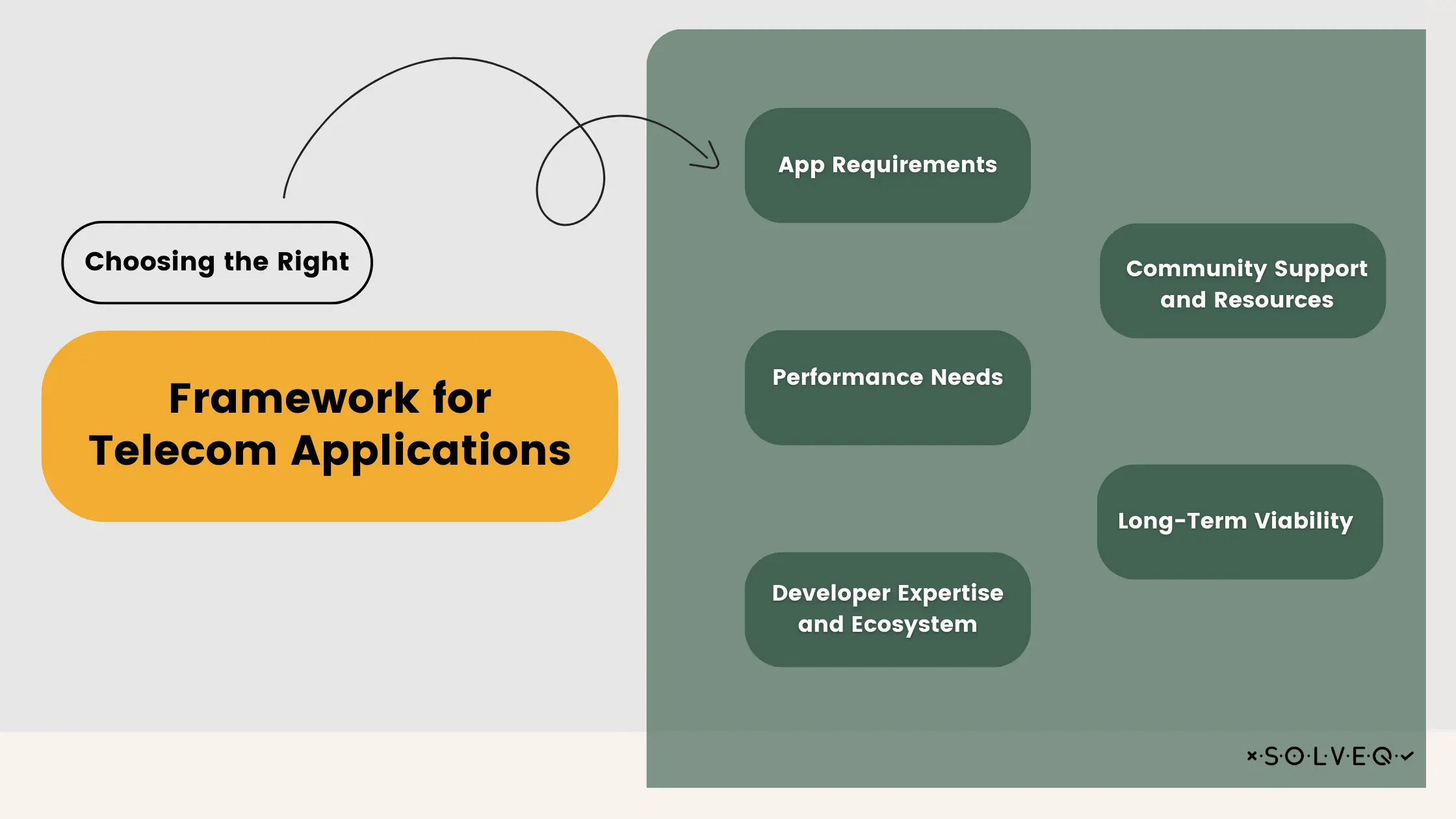Telecom's Digital Transformation: Leveraging Cross-Platform Development for Growth
20 Feb 2024 • 31 min read

Marcin Kulawik

In the fast-evolving world of telecommunications, embracing digital transformation is no longer an option but a necessity. At the heart of this transformation lies cross-platform development—a key strategy that's reshaping how telecom services are delivered and experienced. This article unfolds the vital role of cross-platform development in driving innovation and growth in the telecom sector. Join us as we explore this pivotal theme, understanding why mastering it is crucial for anyone looking to make their mark in today's digital telecom landscape.
Embracing Digital Transformation in Telecom
In the dynamic world of telecommunications, the advent of digital transformation has been a game-changer. This shift is not merely about adopting new technologies; it's a reinvention of how telecom companies operate, innovate, and interact with their customers.
Enhancing Customer Experience through Digitalization
Central to this transformation is the enhanced customer experience. Telecom companies now use AI and machine learning to offer personalized services, swiftly resolve issues, and deliver more efficiently. This focus on customer-centricity is transforming expectations and satisfaction levels, marking a new era in customer engagement.
Operational Efficiency and New Service Offerings
The impact of digital transformation goes beyond customer interaction. Internally, it has streamlined operations, making them more efficient and cost-effective. Automation and advanced data analytics have revolutionized everything from network management to billing systems. This operational efficiency isn't just about cutting costs; it's about creating space for innovation. Telecoms are now exploring new territories, expanding beyond traditional services to embrace cloud computing, IoT, and the potential of 5G. This expansion is not just about new revenue streams but about staying relevant in a rapidly evolving digital landscape.
Cross-Platform Development: A Catalyst for Growth and Innovation
At the heart of this transformation is the significance of cross-platform development. It's a strategy that directly aligns with the need for broader reach and accessibility in today's fragmented digital world. By adopting a cross-platform approach, telecoms ensure their services are accessible across a myriad of devices, enhancing customer reach and experience.
Moreover, cross-platform development is inherently cost-effective. It allows for the creation of versatile applications with reduced development and maintenance costs, an essential factor in an industry where investment in new technologies is continuous and substantial.
This approach also ensures a faster deployment of services, a critical factor in an industry where speed is synonymous with competitiveness. The ability to quickly launch and update services across various platforms means telecom companies can stay agile and responsive to market trends.

Perhaps most importantly, cross-platform development facilitates a consistent user experience. In an era where brand perception is paramount, ensuring that customers receive a uniform experience across all platforms strengthens brand loyalty and satisfaction.
Finally, the cross-platform methodology is ideally suited for integrating emerging technologies like AI, IoT, and big data analytics. This integration is pivotal, not just for creating innovative services but for paving the way for future advancements in the telecom sector.
In summary, the digital transformation in telecom, spearheaded by cross-platform development, is not just about keeping up with technological advancements. It's a strategic reimagining of how telecom companies operate, innovate, and connect in a digital world. It's an exciting journey that promises growth, efficiency, and a new horizon of possibilities.
The Need for Cross-Platform Development in Telecom
The telecom industry's shift towards digitalization has made cross-platform development not just beneficial, but essential. This approach addresses key industry challenges and aligns with evolving market dynamics.
Key Drivers of Cross-Platform Solutions
In an industry driven by rapid technological advancements and changing consumer behaviors, several factors underscore the need for cross-platform development.

- Adapting to Market Demands: The telecom market is experiencing rapid changes, with new technologies and services emerging at an astounding pace. Cross-platform development allows telecom companies to quickly adapt to these changes, offering solutions that are compatible with a wide range of technologies and platforms.
- Meeting Customer Expectations: Today's customers expect seamless and consistent experiences across all their devices. They want the freedom to switch between a smartphone, tablet, or laptop without losing functionality or experiencing a drop in service quality. Cross-platform solutions are essential in meeting these high customer expectations.
- Navigating the Competitive Landscape: In a fiercely competitive market, telecom companies must continually innovate to stay ahead. Cross-platform development offers a way to quickly launch new services and features, keeping pace with competitors and even setting new industry standards.
These drivers highlight the necessity for telecom companies to adopt cross-platform strategies to remain agile and responsive in a rapidly evolving digital landscape.
Challenges Addressed by Cross-Platform Development
Cross-platform development is not just about embracing new technologies; it's also about solving inherent industry challenges.

- Tackling Fragmented User Bases: The diversity of devices and operating systems used by consumers today has resulted in a highly fragmented user base. Cross-platform development addresses this challenge by enabling telecom companies to develop applications that work seamlessly across multiple platforms, thereby reaching a wider audience.
- Reducing High Development Costs: Developing separate applications for each platform can be prohibitively expensive. Cross-platform development significantly cuts down these costs by using a single codebase to deploy on multiple platforms. This approach not only saves money but also streamlines the development process.
- Ensuring Consistency and Quality: Maintaining a consistent look and feel across different platforms can be challenging. Cross-platform development tools help maintain uniformity, ensuring that customers have a consistent experience regardless of the platform they use. This consistency is key to building and maintaining brand loyalty.
- Speeding Up Time-to-Market: In the fast-paced telecom industry, speed is crucial. Cross-platform development accelerates the process of bringing new products and services to the market, enabling telecom companies to be more agile and responsive to emerging trends and customer needs.
By addressing these challenges, cross-platform development not only enhances operational efficiency but also fortifies the telecom industry's capacity to innovate and grow in a digital-centric world.
Understanding Cross-Platform Development Technologies
In the realm of digital transformation, understanding the technologies that drive cross-platform development is crucial. These technologies enable telecom companies to build applications that provide consistent experiences across multiple platforms.
Overview of Cross-Platform Frameworks
The world of cross-platform frameworks is diverse, each offering unique features and capabilities.
- React Native: Developed by Facebook, React Native allows developers to build mobile apps using JavaScript and React. Its primary advantage is the ability to write code once and deploy it on both iOS and Android, making app development more efficient and consistent.
- Flutter: Flutter, created by Google, is another popular framework that uses the Dart programming language. It's known for its high performance and expressive UI, allowing the creation of visually appealing apps with smooth animations and transitions
- Xamarin: A Microsoft-owned framework, Xamarin uses C# and .NET to create apps for iOS, Android, and Windows. It stands out for its ability to leverage a vast array of .NET features and libraries, making it a preferred choice for those already invested in the Microsoft ecosystem.
- Other Frameworks: There are other frameworks like Apache Cordova and Ionic, which offer different approaches and capabilities. Cordova allows web-based apps to be packaged as mobile apps, while Ionic provides a library of UI components for creating hybrid mobile apps.
Choosing the Right Framework for Telecom Applications
Selecting the appropriate framework for telecom applications involves several considerations.

- App Requirements: The nature and complexity of the app play a crucial role. For apps requiring heavy graphics or complex animations, Flutter might be the best choice. In contrast, for apps that need to leverage native functionality extensively, React Native or Xamarin could be more suitable.
- Performance Needs: Performance is key in telecom applications. Frameworks like Flutter and Xamarin are known for their close-to-native performance, which can be critical for apps that demand high responsiveness and speed.
- Developer Expertise and Ecosystem: The expertise of the development team is a significant factor. If the team is proficient in JavaScript, React Native could be a natural choice. Similarly, for teams skilled in C# and .NET, Xamarin might be the preferred option.
- Community Support and Resources: The size and activity of the framework's community can impact development. Larger communities often mean better support, more resources, and a wealth of shared knowledge, which can be invaluable for troubleshooting and development insights.
- Long-Term Viability: Considering the rapidly changing tech landscape, it's important to choose a framework with strong backing and a clear roadmap for future development. This ensures that the chosen technology remains relevant and supported in the long run.
In conclusion, understanding and choosing the right cross-platform development technology is a strategic decision that can significantly impact the success of a telecom company's digital initiatives. The right framework aligns with the app's specific requirements, performance needs, and the expertise of the development team, ensuring a robust, efficient, and future-proof solution.
Benefits of Cross-Platform Development for Telecom Growth
The adoption of cross-platform development strategies has become a cornerstone for growth in the telecom sector. This approach not only aligns with the industry's digital transformation goals but also brings tangible benefits that propel business growth.
Cost Efficiency and Reduced Time to Market
The economic advantages of cross-platform development are significant, especially in terms of cost efficiency and speed.
- Lowered Development Costs: One of the most notable benefits of cross-platform development is the reduction in development costs. By utilizing a unified codebase, telecom companies can develop applications that work across multiple platforms without the need to invest in separate development teams for each platform. This consolidation of resources results in considerable savings in both time and money.
- Accelerated Deployment: With a single codebase, the time to deploy applications across multiple platforms is significantly reduced. This faster deployment not only allows telecom companies to respond quickly to market changes but also provides a competitive edge. In a fast-paced industry, the ability to launch new features and services rapidly is a critical factor for success.
Enhanced User Engagement Across Platforms
In today's multi-platform world, delivering a consistent and engaging user experience is crucial for customer retention and satisfaction.
- Consistency Across Android, iOS, and Web: Cross-platform development ensures that users have a uniform experience whether they are using an Android device, an iPhone, or a web application. This consistency is key to building a strong brand identity and trust among users, as it eliminates the confusion and frustration that can come with platform-specific discrepancies.
- Improved User Engagement: By providing a consistent experience, telecom companies can enhance user engagement. When users know that they can expect the same level of functionality and usability regardless of the platform, they are more likely to use the services more frequently and for longer periods.

Scalability and Maintenance
The scalability and ease of maintenance of cross-platform applications are critical for adapting to evolving user demands and technological advancements.
- Easier Updates and Maintenance: Updating and maintaining a single codebase is far more efficient than managing multiple native applications. This streamlined process means that telecom companies can quickly roll out updates, fix bugs, and add new features, ensuring that their applications remain current and competitive.
- Scalability to Meet Growing Demands: As user numbers grow and their needs evolve, telecom companies need to scale their services accordingly. Cross-platform applications offer the flexibility to scale up (or down) more easily than their native counterparts. This scalability is essential in an industry where user demands and market conditions can change rapidly.
In summary, the benefits of cross-platform development for telecom growth are multifaceted. This approach not only offers cost efficiency and a faster time to market but also ensures enhanced user engagement and scalable, maintainable solutions. As the telecom sector continues to evolve, cross-platform development stands as a key enabler for sustainable growth and innovation.
Real-World Applications: Cross-Platform Development in Action
In the telecom industry, several leading companies have adopted cross-platform development to enhance their services and customer experience. These real-world examples highlight the practical applications and successes of this approach.
Case Studies of Successful Telecom Apps
- Vodafone’s TOBi Chatbot: Vodafone, a multinational telecom company, introduced TOBi, an AI-powered digital assistant developed using cross-platform technologies. TOBi provides customer support across various platforms, handling inquiries and assisting in online purchases. This implementation not only improved customer service efficiency but also enhanced user engagement across different devices.
- T-Mobile’s TVision App: T-Mobile USA launched TVision, an entertainment streaming service, utilizing cross-platform development to reach a wider audience. The service was accessible on multiple platforms, including iOS, Android, and smart TVs, providing a consistent user experience across devices. This approach allowed T-Mobile to expand its service offerings beyond traditional telecom services, tapping into the growing demand for streaming content.
- AT&T’s Smart Home Manager: AT&T developed its Smart Home Manager app as a cross-platform solution to manage home Wi-Fi networks. The app, available for both iOS and Android users, allows customers to personalize and control their home network settings from their smartphones. The success of this app lies in its user-friendly interface and the convenience it offers to AT&T's broadband customers.
Innovative Features Enabled by Cross-Platform Technologies
These case studies also shed light on the innovative features enabled by cross-platform development in the telecom sector:
- Integration of AI and Machine Learning: Vodafone’s TOBi chatbot showcases the integration of AI to improve customer interaction, providing a more personalized and efficient customer service experience.
- Multimedia and Streaming Services: T-Mobile's TVision app exemplifies how telecom companies can diversify their offerings, incorporating streaming services that are accessible across various platforms, thereby broadening their market reach.
- IoT and Smart Home Applications: AT&T’s Smart Home Manager app demonstrates the integration of IoT in telecom services, allowing users to manage their home devices seamlessly, a step towards a more connected and smart living experience.
These examples demonstrate how leading telecom companies are leveraging cross-platform development to innovate and expand their services. This approach not only enhances customer engagement but also opens new avenues for growth in an increasingly digital world.

Best Practices for Implementing Cross-Platform Development in Telecom
Implementing cross-platform development effectively in the telecom industry requires a strategic approach and a keen focus on quality, performance, and security. Here are some best practices to guide telecom companies in this endeavor.
Strategic Planning and Framework Selection
The foundation of successful cross-platform development lies in thoughtful planning and choosing the right framework.
- Aligning with Business Objectives: It's crucial for telecom companies to align their choice of cross-platform framework with their overall business objectives. This means understanding the specific needs of the target audience, the intended functionality of the app, and how these align with the company's long-term goals.
- Evaluating Framework Capabilities: Different frameworks offer varied capabilities. It's important to evaluate these in the context of what the application aims to achieve. Factors like support for offline functionality, integration capabilities with other services, and the ability to handle complex operations should guide the selection process.
- Future-Proofing: The chosen framework should be sustainable and supported in the long term. This involves considering the framework's roadmap, community support, and the backing of the organization that develops it.
Ensuring Performance and Quality
Maintaining high performance and quality is paramount in delivering a successful telecom app.
- Regular Testing on Multiple Devices: Continuous testing on various devices and platforms is essential to ensure consistent app quality and performance. This helps in identifying and resolving platform-specific issues early in the development process.
- Performance Optimization: Telecom apps often require handling large volumes of data and real-time communications. Optimizing app performance for these tasks, while ensuring minimal battery consumption and efficient data usage, is crucial.
- User-Centric Design: A focus on user experience design is key. This involves creating intuitive, easy-to-navigate interfaces and ensuring the app looks and feels consistent across different platforms.
Security Considerations
In the telecom industry, where sensitive user data is often handled, prioritizing security is non-negotiable.
- Data Protection and Encryption: Implementing robust data protection measures, including encryption of user data both in transit and at rest, is essential. This is particularly important for apps that handle payment transactions or personal customer information.
- Compliance with Regulations: Telecom companies must ensure their apps comply with relevant data protection and privacy regulations, such as GDPR in Europe or CCPA in California. This involves regular audits and updates to the app as these regulations evolve.
- Implementing Secure Authentication: For apps that provide access to customer accounts or sensitive data, secure authentication methods, such as two-factor authentication, should be implemented.
- Regular Security Updates and Patching: Continuous monitoring for vulnerabilities and regular updates to the app are necessary to safeguard against emerging security threats.
By adhering to these best practices, telecom companies can effectively implement cross-platform development strategies that align with their business objectives, while ensuring high performance, quality, and security of their applications. This holistic approach is key to leveraging the full potential of cross-platform technologies in the telecom sector.
Overcoming Challenges in Cross-Platform Development
While cross-platform development offers numerous benefits, it also comes with its own set of challenges. In the context of telecom, addressing these challenges is key to delivering high-quality, efficient, and user-friendly applications.
Addressing Performance Bottlenecks
Ensuring that cross-platform apps perform well across all devices is crucial.
- Optimized Code: Writing efficient and optimized code is fundamental. This involves avoiding unnecessary computations, minimizing memory usage, and making use of asynchronous programming where appropriate to keep the app responsive.
- Leveraging Native Modules: For performance-critical parts of the app, leveraging native modules can be beneficial. This means writing those parts of the code in the native language of the platform (Swift for iOS, Kotlin for Android) to ensure optimal performance.
- Effective Use of Caching and Data Storage: Implementing smart caching strategies and efficient data storage can significantly improve app performance, especially in handling large volumes of data common in telecom applications.
- Performance Testing and Profiling: Regular performance testing and profiling are essential. This helps in identifying and addressing any performance bottlenecks early in the development process.
UI/UX Consistency Across Platforms
Maintaining a coherent and appealing design across different platforms is a significant challenge.
- Responsive Design Principles: Implementing responsive design principles ensures that the app’s layout adapts seamlessly to different screen sizes and orientations.
- Platform-Specific Design Adaptation: While consistency is key, it's also important to adapt certain UI elements to match the design language of each platform (e.g., navigation patterns, button styles) to ensure that the app feels native to each platform.
- Regular User Testing: Conducting regular user testing on various platforms can provide valuable feedback on the UI/UX consistency and help identify areas for improvement.
Accessing Native Features and APIs
Making the most of device-specific capabilities is a challenge when working with a cross-platform framework.
- Bridging for Native Features: Utilizing bridging techniques allows cross-platform apps to access and use native features and APIs of the device. This involves writing some platform-specific code and integrating it with the cross-platform codebase.
- Utilizing Cross-Platform Plugins and Modules: Many cross-platform frameworks offer plugins and modules that provide access to native features. Regularly updating these plugins and ensuring they are compatible with the latest platform versions is important for smooth functionality.
- Balancing Cross-Platform and Native Solutions: In some cases, it may be more efficient to develop certain features natively for each platform, especially if those features are heavily dependent on the device’s hardware or require extensive access to native APIs.
By addressing these challenges with strategic and thoughtful solutions, telecom companies can enhance the effectiveness of their cross-platform development efforts, ultimately leading to the creation of robust, efficient, and user-friendly applications. This careful balancing act between leveraging cross-platform efficiencies and maintaining high performance and quality is key to the success of telecom apps in today's digital landscape.

The Future of Cross-Platform Development in Telecom
The telecom industry, always at the forefront of technological innovation, is poised to see significant shifts in the coming years. Cross-platform development, integral to this evolution, will be influenced and reshaped by emerging technologies and trends. Understanding these dynamics is key to preparing for the next generation of telecom services.
Emerging Technologies and Trends
Upcoming technologies are set to redefine the landscape of cross-platform development in telecom.
- Influence of 5G: The rollout of 5G networks will dramatically enhance the capabilities of telecom applications. Cross-platform apps will need to be designed to leverage the increased speed and lower latency of 5G, enabling more sophisticated and demanding features such as augmented reality (AR) and virtual reality (VR) integrations.
- Edge Computing Integration: As edge computing becomes more prevalent, cross-platform development will need to adapt to handle more computing on the device's edge. This shift will require a rethinking of data handling and processing within apps, focusing on real-time data processing and reduced reliance on central servers.
- Blockchain for Enhanced Security: The incorporation of blockchain technology could offer new ways to secure cross-platform applications, especially in handling sensitive customer data and transactions. This could be particularly transformative in ensuring transparency and security in customer interactions and services.
- Artificial Intelligence and Machine Learning: AI and ML are becoming increasingly integral to telecom apps, offering personalized experiences and smarter services. Cross-platform development will need to seamlessly integrate these technologies to provide intelligent and adaptive user experiences.
Preparing for Next-Generation Telecom Services
Cross-platform development will play a pivotal role in shaping future telecom innovations and customer experiences.
- Enhanced Customer Experiences: With technologies like 5G and AI, telecom services can become more interactive and personalized. Cross-platform apps will be at the center of delivering these enhanced experiences, providing consistent service across multiple devices and platforms.
- Readiness for IoT Expansion: As the Internet of Things (IoT) continues to expand, telecom apps will need to manage an increasing number of connected devices. Cross-platform development strategies will have to focus on interoperability and the ability to integrate a wide range of IoT devices and services.
- Adaptability to New Technologies: The future of telecom will demand rapid adaptability to new technologies. Cross-platform development approaches must be flexible and scalable to integrate emerging technologies quickly and efficiently.
- Focus on Modular and Scalable Architectures: To keep pace with rapid technological changes, telecom apps will need to adopt modular and scalable architectures. This approach will enable easier updates and integration of new features, keeping apps relevant and up-to-date.
In conclusion, the future of cross-platform development in telecom is intertwined with the evolution of cutting-edge technologies. Telecom companies must stay abreast of these changes, adapting their cross-platform development strategies to meet future demands and seize new opportunities. This forward-thinking approach will be crucial in maintaining a competitive edge and delivering next-generation services to customers.
Summary
As the telecom industry navigates through its digital transformation, cross-platform development emerges as a pivotal force, driving innovation and user engagement. This article has highlighted the importance of choosing the right frameworks, ensuring performance and quality, and integrating emerging technologies like 5G and AI for future-ready telecom applications. We've also explored real-world successes and best practices, demonstrating the profound impact of cross-platform strategies. Embracing these approaches offers a path to not only meet but exceed the evolving demands of the digital era. For tailored solutions that harness the power of cross-platform development, look no further than our expertise at SolveQ.
Share:
Looking for expert development team?
Schedule a call with Tech Consultant

Marcin Kulawik
Founder and CEO of SolveQ. Huge fan of building things with purpose, agility, and having fun while changing the World. Loves his family, teammates, and nature.